- Google Slides Presentation Design
- Pitch Deck Design
- Powerpoint Redesign
- Other Design Services

- Guide & How to's

The ultimate guide to creating an ideal elevator pitch presentation in 2023
What is an elevator pitch? What is an elevator pitch designed to do? And even more importantly – what makes a good elevator pitch? It is probably one of the most common presentation types – and it’s easy to see why. It is brief, effective, and utterly universal since you can use this format in pretty much any sphere – from business to making friends. So, let’s find out exactly what it is and how to make an ideal elevator pitch!

Elevator pitch meaning
An elevator pitch, sometimes referred to as an elevator speech, is a brief, memorable summary of your professional background, product/service, expertise, and credentials. This type of presentation should be quick enough to present during a short elevator ride, which is why it’s called an elevator pitch.
This speech is entirely about who you are, what you sell or currently do, and what you plan to do in the future.
Think of it as a Twitter version of your business proposal/plan. You can use over 140 characters to share your ideas during a 60-second elevator ride but only share up to 3 tweets’ during the first contact. The reason is simple: the average English word has 5.5 characters with spaces, and a 140-character tweet is equal to 25 words.
Pro tip: In your elevator pitch, speak at a comprehensible 75 words per minute (a little slower than the usual pace of 120-200 words/minute).
Done right, this speech will help you make a solid first impression on potential investors, employers, or business partners. It can also aid in network development, employment, or establishing connections with new coworkers on your first day at a company. You might even learn something new about your business that you never knew before!
Is this something you are interested in trying?
Good! Because we’ll soon show you how to do it!
Key takeaways:
- Aim to convey your message in no more than 60 seconds and keep your elevator speech short and to the point.
- Maintain a maximum of 75 words per minute.
- With the limited time you have, be enthusiastic and persuasive. Concentrate on the most critical details.
- Use visual aids to grab attention.
- To ensure that your speech is effective, record it or deliver it to a friend. Remember, practice makes perfect.
What is an elevator pitch deck designed to do?
To put it shortly, an elevator pitch is designed to introduce either you or your product or service. Keep in mind that your audience would likely be strangers. Your goal here is to catch their attention and spark interest.
Depending on what you want to achieve, there may be different types of elevator pitch presentations:
- Introductory elevator pitch – fits anywhere from job interviews to sales campaigns and fundraising events – wherever you need to introduce yourself or your product/service.
- Job interview elevator pitch – fits for making a fast overview of your skills and competencies for your potential employer.
- “Selling” elevator pitch for business – fits for either selling your product or getting funding to make one.
Remember, your elevator pitch is as helpful during online networking events, job interviews, and trade fairs as in person.
In this article, we’ll show you how to craft a powerful elevator pitch ppt to attract investors.
What constitutes a good elevator pitch?
The purpose of elevator pitch slides is to give clear and crisp information about yourself or your product/service. That’s why your deck should contain only a few slides. The perfect elevator pitch deck is anywhere between 5 to 12 slides, with smart art and charts.
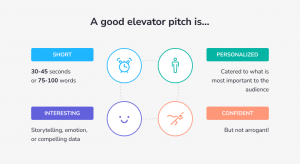
How to do an elevator pitch for business?
There are a ton of elevator pitch examples available online. And every one of those samples follows a slightly different format template.
This raises an important question: which one is the best?
We at SlidePeak will try to provide a clear answer to that question in this elevator pitch guide. Having explored many alternative options, we found our winning template, which we will now share with you.
Our elevator pitch presentation is divided into 8 sections:
- Introduction
- Problem vs. solution
- Market size and competition
- Business model
- Unique selling point (USP)
- Founding team
- Money milestones
- Call to action (CTA)
Here’s a quick overview of what each elevator pitch slide deck section includes and why:
Section 1: Introduction
You might be tempted to begin an elevator pitch with something startling. After all, you want to draw the investor’s attention, don’t you?
The issue with shocking starters is that they may draw the investor’s attention away from your business, which is the main focus of your pitch. That’s why we recommend starting out naturally rather than shockingly and putting information on 1-3 slides to make the information easy to understand.
You should include these elevator pitch essentials in your introduction:
- The name of the business
- A concise summary of your business (no more than two sentences)
- A breakdown of the top three products/services you offer (optional)
- Your target audience
Make sure to relate all details in no more than 18 seconds or 36 words max. By briefly outlining the details, you give the potential investor a basic grasp of what you do.
Good examples:

Pro tip: You can skip the target audience if it is obvious, like in the example above (anyone can benefit from social media). For other products/services, this is a crucial component that should be clearly defined.
Starting your elevator pitch PowerPoint with a question or hook is also an excellent way to attract the investor’s attention. In such a case, add one more slide before the introductory one.
Example 1: Starting with a question

Example 2: Starting with a hook or interesting fact

The pitch’s beginning or conclusion might both contain a hook. If you’re cold-pitching and use your hook at the beginning, your audience might be intrigued. A lengthier conversation will begin if you place it near the end of your speech during a networking event or job interview.
Section 2: Problem vs. solution
The next section has to throw light on the problem you’re attempting to solve. It can consist of one main problem statement, several smaller ones that are related to it, or one main problem divided into two to three smaller ones.
The objective is to demonstrate that you fully understand the challenge and quickly tell them about the solution you offer. The simpler to understand, the better.
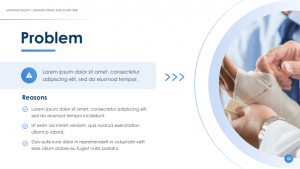
Section 3: Market size and competition
Potential investors are always more likely to invest where they can expect substantial returns. That’s why demonstrating the scale of the opportunity and insights into the competition gives an immediate sense of whether they should invest their time with you.
Good example:
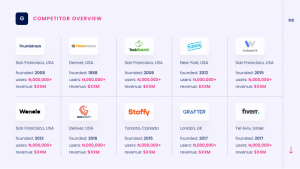
Section 4: Business model
An investor can get a sense of how you plan to make money with a fast elevator pitch slide on the business model. An investor is more likely to convert when a business strategy is clear and compelling.
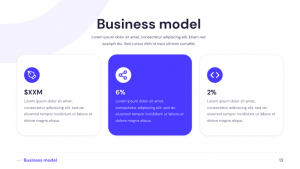
Section 5: Why choose us or our USP
Your objective in this section is to show potential investors how your company stands out from the competition. At this point, they decide whether or not to spend more time with you.
If they want to hold a second listening to you, you are more likely to get funding.
Pro tip: You should be mindful that you have a maximum of 20 seconds to highlight your USP. Therefore, keep information to a minimum and provide details that are absolutely necessary for your investors to know.
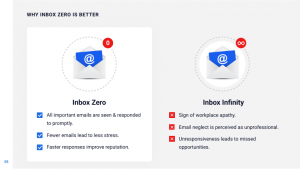
You can also add a slide describing your technology if you offer high-end, technologically oriented products or solutions. If it’s a patented technology, make sure to put it forward during your elevator pitch.
Section 6: Founding team
People invest in people.
Investors are interested in the credentials of the people they spend their money and effort on. To inspire trust in potential investors, always include your credentials, experience, and accomplishments.
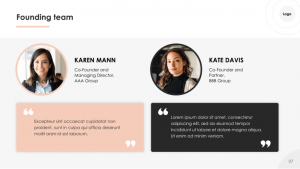
Section 7: Money milestones
Investors absolutely love numbers and will remember them long after your elevator pitch is over. Therefore, make sure to demonstrate a well-thought-out investment process right from the start.
A good example from Airbnb:
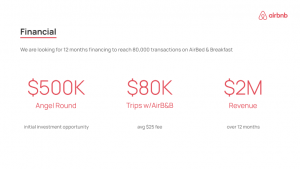
How to speak at an elevator pitch?
Now that we’re finished with the content part, let’s talk about how you should speak at an elevator pitch.
Actually, time may be quite an enemy here. You start talking faster because you are worried, and there’s so little time for you to speak. And if you are a fast talker, this may result in your pitch feeling rushed and hard to follow.
Try keeping a relaxed approach to how you speak. Your steady and clear rhythm will create a feeling of confidence in what you are talking about. This will result in credibility and give you the highest possible impact.
How to end an elevator pitch?
The ending is as important as the beginning, if not more! In fact, the more creative you can be, the more successful your elevator pitch will be.
You need to consider a concluding statement that will stick in the investor’s mind. The better the line, the more likely your potential investor will remember your message afterward.
This memory trigger could be anything from a catchy phrase to a promise of value. It can be a summary of the pitch. If you can make it rhyme, bonus points for you!
You can also ask whether further explanations are needed, initiate a discussion, or offer your business card – whatever attracts attention and makes your pitch memorable.
What to avoid in an elevator pitch?
The key thing in an elevator pitch, apart from its size, is clarity.
Here are 6 things you should avoid when you write your elevator pitch.
- Avoid truisms, buzzwords, hyperbole, and jargon. Some people can be impressed, but many others will be confused.
- Don’t speak too fast or ask too much of people.
- Weed out fillers and annoyances.
- Don’t give your elevator speech to people who don’t want to hear it or are in a hurry.
- Don’t take a one-size-fits-all approach. Make sure to refresh your pitch if the situation changes.
- Don’t speak in a monotone way or frown. Instead, aim for high energy.
Finally, think about how you move and what you do during your elevator pitch. Too many gestures and overall movement may appear annoying, while not moving at all will make you sound odd. So, try to strike a balance and always be ready for objections!
Some good examples to follow:
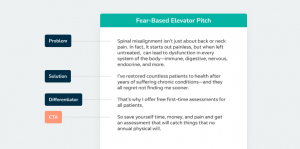
The presentation part
The design, appearance, and feel of the deck have an equal impact on your elevator pitch’s success, as does accurately communicated information.
Do not shy away from receiving professional assistance to get the elevator pitch design done. After all, it is your idea that should succeed – an effective elevator pitch deck simply opens the door.
Quick tips for elevator pitch that stands out
- Keep it concise, short, simple, and visually appealing.
- Select bold fonts.
- Give preference to contrasting backgrounds.
- Use words, fonts, and images that are easy to understand.
- Avoid putting all the information in a single slide –the less information, the better.
- Avoid using free stock images – instead, use few but relevant ones.
The bottom line
Stick with the elevator pitch guidelines we’ve offered in this article, and you will present your business with class and style. And if you have any questions or need assistance creating an elevator pitch, feel free to contact our team at any time convenient for you.
We’re always happy to assist business owners and startups in expanding their marketing efforts!
#ezw_tco-2 .ez-toc-widget-container ul.ez-toc-list li.active::before { background-color: #ededed; } Table of contents
- Presenting techniques
- 50 tips on how to improve PowerPoint presentations in 2022-2023 [Updated]
- How to present a research paper in PPT: best practices
- Present financial information visually in PowerPoint to drive results
- Keynote VS PowerPoint

- Business Slides
New product launch #1: product pitch

- Design Tips
A complete guide to perfect pitch deck design: structure, tips & examples

How to find investors on LinkedIn for my startup
Home Blog Business Elevator Pitch Guide: The Essentials to Elevator Pitch Presentations
Elevator Pitch Guide: The Essentials to Elevator Pitch Presentations

In her book Resonate , communication and Persuasion Expert Nancy Duarte, a highly praised master of turning story patterns into effective business communications, recommends “Showing your humanness when you present” as a “great way to stand out.” Yet, how do we manage to do that over a conversation that can only last as long as an elevator ride, at best? We’re focusing on elevator pitches over this note, aiming at strengthening your skills in delivering a successful elevator pitch for business in a way that brings your company, efforts, and ideas the best success moving forward.
Table of Content
What is an elevator pitch?
How long should an elevator pitch be, elevator pitch real-life applications, the basic structure for an elevator pitch, recommendations on delivering your elevator pitch.
- Four Effective Elevator Pitch Examples (with Real-Life Experiences)
According to elevator company Kencor, Inc. , vertical lifts “have variable ride times”. An elevator ride in a small town in Kentucky is certainly not the same as one in New York City. The reason “there may be considerable differences in terms of speed”, as CMA Lifts states, is “because one thing is having to serve maybe a four-story building and much more is having to do with a building that in turn goes to touch a dozen.” Times will vary depending on the type of elevator, too, amount of a building’s stories, and stops made on the way.
In Taipei 101, which CMA presents as “the third highest skyscraper in the world,” a lift can travel 60.6 km to reach the 89th floor “at an altitude of 382 meters, in a time frame of about 40 seconds.” Why does this matter? We can use these times as a starting reference.

The concept of an “elevator pitch” is most clear when we think of the length of an elevator ride as that timeframe in which you can make a perfect introduction to a potential investor or stakeholder.
The content of a perfect elevator pitch should be succinct, direct, and plentiful . It’s also certainly one you polish every time you deliver it.
A highly esteemed 30 seconds is the common industry rule for a winning first impression. A half-minute capsule is the average notion of an elevator pitch length. This is one common reference point for elevator pitches.
The second common standard for elevator pitches is based on a higher ride average stemming from New York City. Harvard Business Review (HBR) actually goes for this higher elevator ride average of 118 seconds. Of course, the higher amount of skyscrapers in that multicultural place makes up for the considerable difference.

Whether you’re settling for the standard 30 seconds or allowing yourself an extension of up to 118 seconds, the truth is that elevator pitch rides are quick, efficient, and to the point. The goal is to sell your idea or product as fast as the attention you’re likely to get during a single elevator ride.
The above is very much tied to the standard sitcom, TV, and movie scene of someone selling an episode, a project, or any idea while catching up to the jam-packed, unattainable executive everyone wants a hold of as they walk into the office.
If we stick to this produced idea of an elevator ride that we see on screen, the most common real-life application is a key potential investor or customer, a person we wish to attract to whom we, in our minds, say: “If only I could pitch my idea to this person for a single minute, I’d sell it!”
A conference, a demo-day presentation, product launches , and many other networking events are the real-life equivalent of what we see on TV (as in a Shark Tank episode).
In general, elevator pitches are used to pitch a startup, engage in sales, introduce oneself, present a new venture to a venture capitalist, and even seek a job, even.
As we said when we presented our Creative Elevator Pitch Deck PowerPoint Template , “The Elevator Pitch for Interview enables users to demonstrate their career portfolio in an engaging manner.” Someone who walks into an office or casually discusses their career over a taxi ride in a way that succinctly showcases their expertise and abilities is much more likely to catch attention for an open position than someone without clarity or ability to express their thoughts, goals, and desires.
A well-thought-out elevator pitch for a role or as a presentation to a startup, even as a project description in a nutshell, is similar to a very powerful wild card that you pull up your sleeve when that person you know meets you by chance as much as gives you a quick 15-minute introduction to prove your point. Whether an investor can call you back during a 10-minute break or you run into a key business partner in a hallway, on the way somewhere, or at a quick reception at any event, an elevator pitch is destined to convey your ideas across very succinctly so you can pick up longer conversations (or pitches) at a more convenient or later stage.
As we also said in the article to the template above, “business owners and managers use elevator pitch PowerPoints to discuss ideas briefly.” Templates and business presentations in this category of elevator pitch decks serve the useful purpose of putting ideas up on screen in a nutshell for focused discussion. And that’s usually highly appreciated.
Further below, we’ll get to a real-life example of a pitch that worked great for Carmine Gallo in working with an esteemed language interpretation company in Monterrey, California.
For now, if you’re looking to know more about “interview presentations”, including an Elevator Pitch Example for Job Seekers, our article How to Give A Compelling Interview Presentation: Tips, Examples, and Topic Ideas is here to help. We’ll get to more elevator speech examples for entrepreneurs in the section below, as well.
For now, how do we ideally present our elevator pitches?
Create visually appealing presentations as much as possible. The goal is for your visuals to give power and create engagement that adds to your message or speech. This can be done either by carefully pairing your presentation templates so the aesthetic remains cohesive, or opt for a software solution like the SlideModel’s AI presentation maker to speed up slide design process. Then, also work very conscientiously on your messaging.
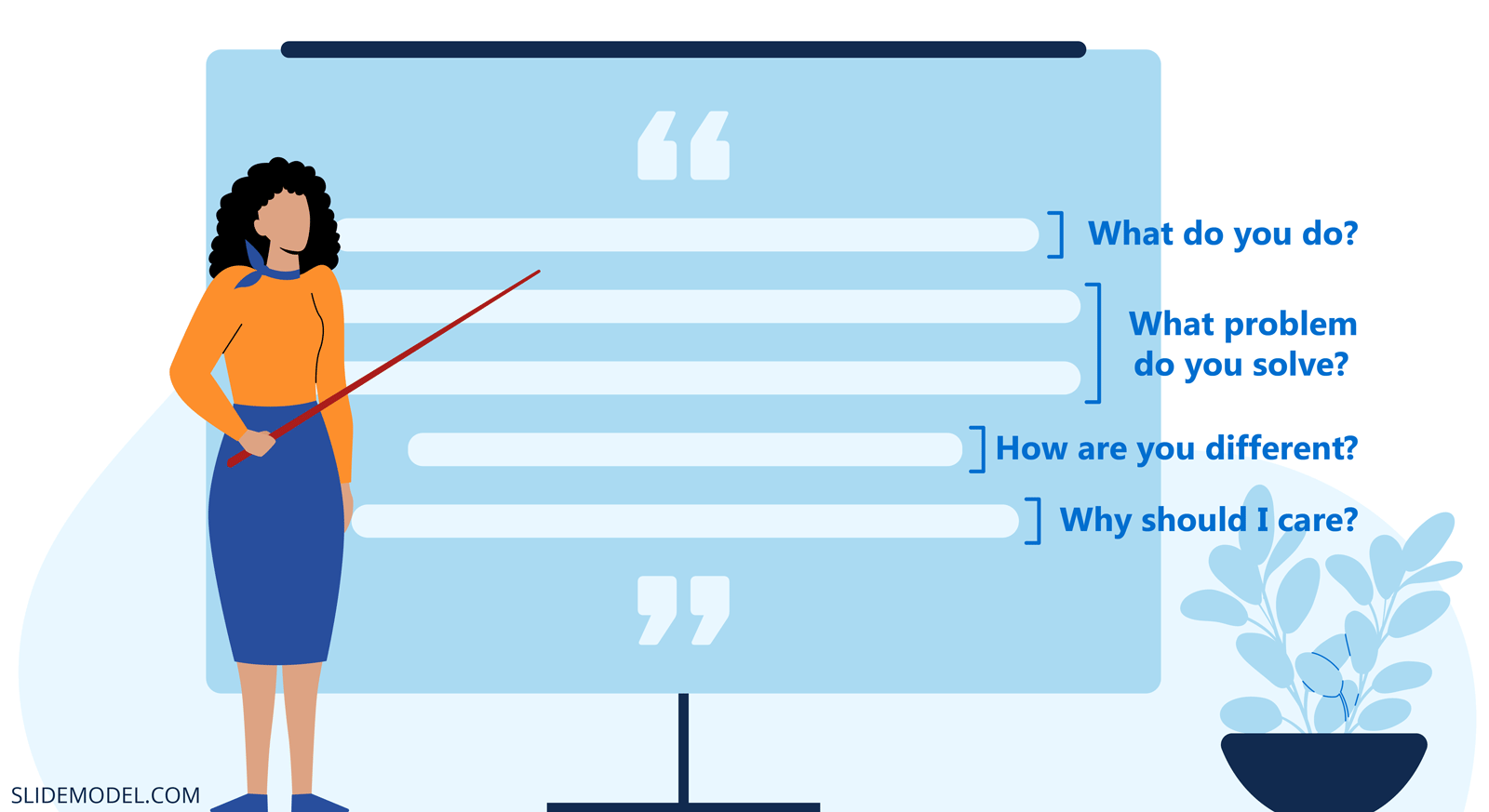
As Nancy Duarte says, “Truly great communicators make it look easy as they lure audiences to adopt their ideas and take action.” To learn how to deliver a presentation pitch, and if we can expand on what the author says, this “isn’t something that just happens automatically; it comes at the price of long and thoughtful hours spent constructing messages that resonate deeply and elicit empathy.” Make sure you put in your focused, attentive hours constructing that ideal message that will resonate with your audience to make them take action. Results will be noticeable if you do, and your confidence in delivering these speeches will naturally and greatly improve as you move forward. This long-term exercise is about being in control of what you’re gearing and how you’re doing so.
As the already-referenced HBR article states, “The first 8 seconds are the ‘hook’—the time you have to get the ‘lean in’ factor, to snag your prospect, to catch their interest.” For them, “Those first 8 seconds are the key”, as HBR puts it. And that’s essentially so because this first span is where we most commonly capture an audience’s full attention before we naturally lose it.
Thereafter, you’re looking to answer a few key questions for your audience. In Presentation Secrets of Steve Jobs – How to be Insanely Great in Front of Any Audience , for example, Carmine Gallo breaks down the ultimate elevator pitch by recommending a presenter: “Simply create a one-sentence answer for the following four questions: (1) What do you do? (2) What problem do you solve? (3) How are you different? (4) Why should I care?”
As promised, here’s what a winning elevator pitch looked like for Gallo in working with an interpretation company (which we labeled here as XYZ) in Monterrey, California:
XYZ company…
“is the world’s largest provider of phone interpretation services for companies who want to connect with their non-English-speaking customers [what it does] .
Every twenty-three seconds, someone who doesn’t speak English enters this country [the problem] .
When he or she calls a hospital, a bank, an insurance company, or 911, it’s likely that an […] interpreter is on the other end [how it’s different] .
We help you talk to your customers, patients, or sales prospects in 150 languages [why you should care] .”
Quite succinctly and like we also said in our Creative Elevator Pitch Deck PowerPoint Template , whenever you’re figuring out how to write an elevator pitch, think of ways “to deliver the concept to an audience in a short description that listeners can easily understand.” The pieces of advice we give above should all assist in knowing how to present an elevator pitch successfully. But we’ve for further recommendations to this end.
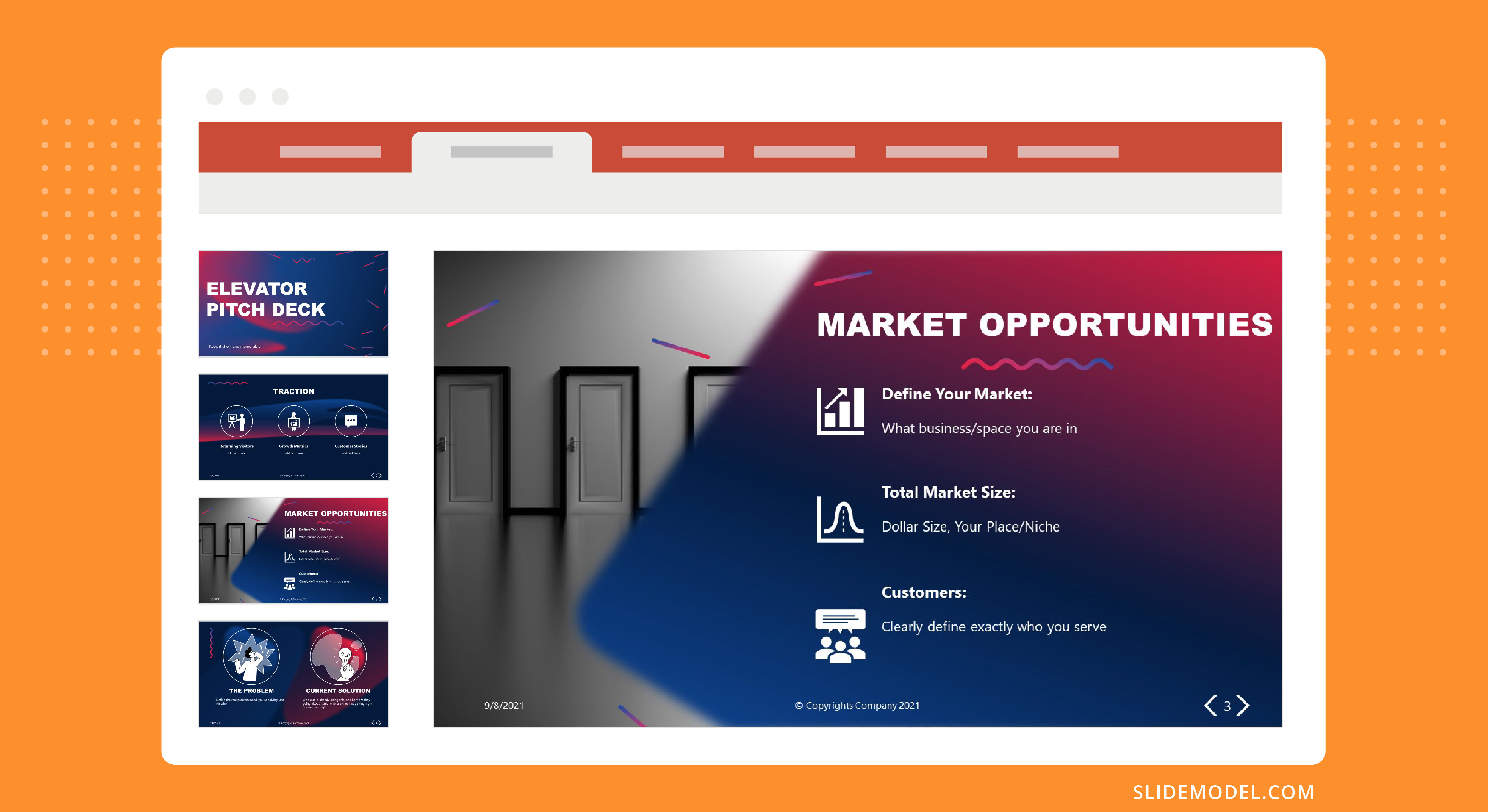
The first of our recommendations has to do with pacing. Just because an elevator pitch is expected to be of short duration, that doesn’t mean you need to race through it. Keep it intelligible. Take your time to breathe. Go slowly at it so your ideas can come through to your audience. Don’t rush through an elevator speech just so you can make up for the short time allowed. Practice, instead. Make sure you choose the right words and learn them by heart. Then, move slowly through them.

The above leads us to our second piece of advice. If you’re building a perfect elevator pitch, revise, edit, and check again! Go through each word many times until you find the right-suiting one for the precise idea or concept you wish to convey. Get them right!
Also, if you’re looking for an elevator pitch presentation template specially designed for presenting to VCs, angel investors, or stakeholders, for example, seek out specialized material. Our Formal Elevator Pitch Template for PowerPoint might work better in that case. The material is a framework of various slides designed for users to customize and perfect their sales pitches. You’re starting off with a base.
On the other hand, seek to put yourself out there to family and friends. Especially seek business partners, colleagues, and people in and out of your field who can tell you how you’re doing with your elevator pitch for business. Rather than fight, be offended, take observations or corrections personally, and let alone justify your pitch’s content as you present to people outside the industry, seek to truly listen to feedback, take note, and make sure you incorporate it later.
The reason behind this observation is that a perfect business pitch contemplates the human aspect of everyone listening. As Duarte puts it in her book, “Even with mountains of facts, you can still fail to resonate. That’s because resonance doesn’t come from the information itself, but rather from the emotional impact of that information.” So, seek to connect emotionally.
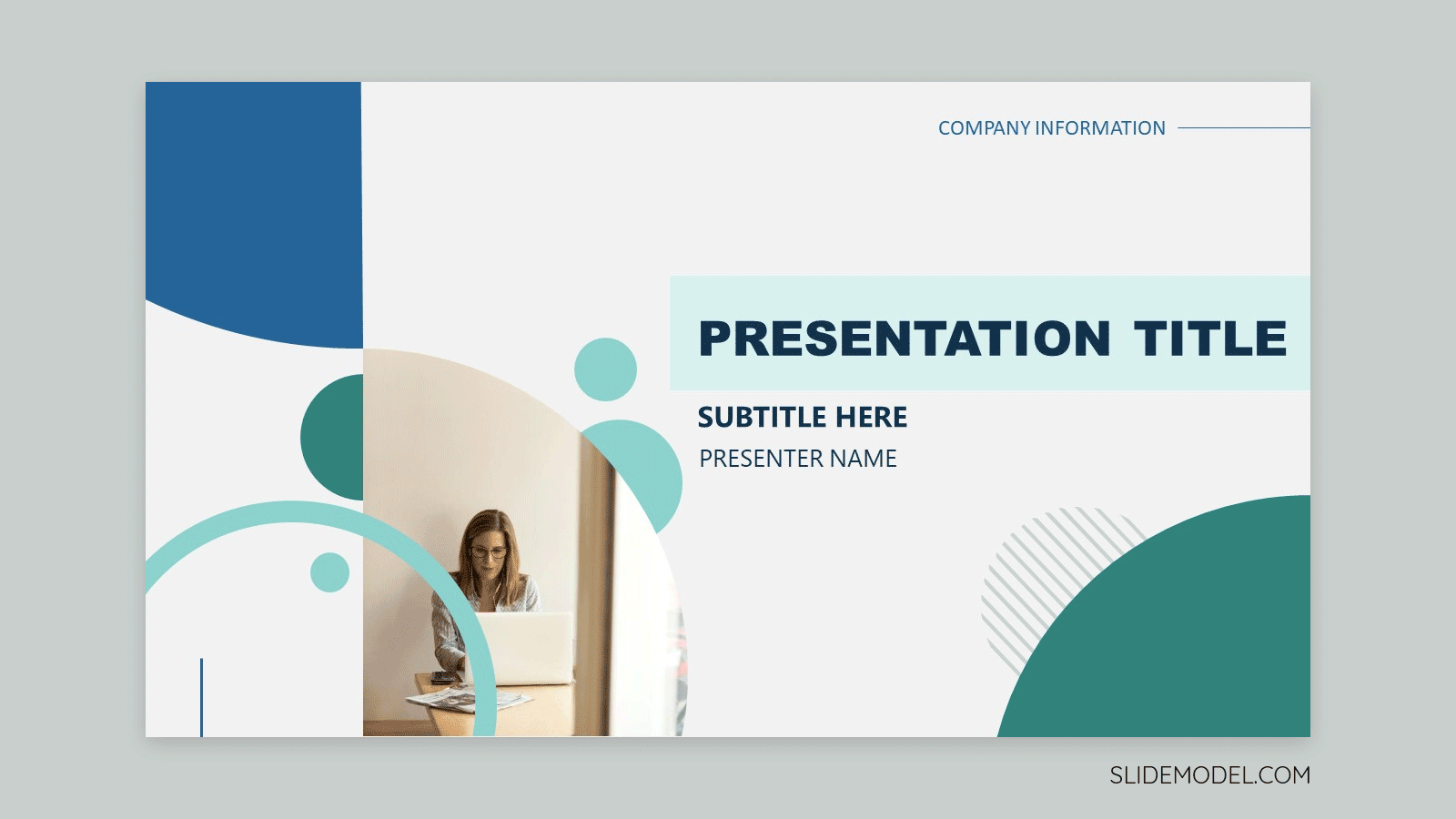
Acknowledging emotion is frequently left out of everything business-related; yet, note how specialist Duarte recommends presenters “Use plenty of facts, but accompany them with emotional appeal.” Listen to your audience and polish your content and delivery until you can sync both the importance of data with the emotional calling that gets audiences to forget what and how you said it, but they walk away changed, with a new vision, and, more importantly, ready to support you and your endeavors.
Let’s check how people have achieved this before you.
Four Effective Elevator Pitch Examples (with Real-Life Experiences )
Our first examples of elevator pitches come from a German impact food startup. Though a bit on the longer side with a final 3-minute length, the video introduces the problem and solution flowingly with a captivating start. It includes benefits, creates an overall experience in itself for viewers as it appeals to the senses, and also incorporates a concise call to action that describes exactly where their efforts will be focused. This is a good example to get started in perfecting your upcoming elevator pitch.
From the college side, Utah State University’s Cooperative Extension Services has an elevator pitch winner who made a compelling business case in less than 2 minutes. This is a perfect example of a 118 elevator pitch that needs a bit of pacing down to be perfect. Instead of rushing, this coffee cup business idea can easily be conceived to go much further on a slower scale. The pitch merits it. Yet, the data and sentiment, the surprise, and all the background work are there, making this a great academic example that can easily guide any executive into winning business presentations.
On the last note, The National Science Foundation came up with a video series on elevator pitches titled “Real People. Real elevators.” Check out episode 2 here for tips with a real-life dramatization and setting if you’d like to picture the situation of a real-life example a bit further.
Now that we’re moving to the more cinematic side, one of Vince Vaughn’s characters has also made a point on product elevator pitches that we can rescue in a light spirit. The reason is that Vince’s character’s pitch works thanks to how he conveys a clear business idea with a captivating (though risky!) introduction to selling a powerful concept to a group of executives. The scene appears fueled by a writing team that apparently knows the back works of pitching an idea fairly well. Here’s what’s been labeled as “The best elevator pitch of the world” in a YouTube clip of 2011’s movie Dilemma .
Here, we provide a range of elevator pitch examples to cater to different scenarios:
Business Elevator Pitch Examples:
Imagine you are the founder of a sustainable fashion startup, and you’re pitching your idea to a potential investor:
“I’m the founder of GreenStyle Apparel. We’re disrupting the fashion industry by producing high-quality, eco-friendly clothing made from recycled materials. With a growing consumer demand for sustainable fashion and our innovative supply chain, we’re well-positioned to capture a significant market share. Our recent partnership with [Notable Retailer] has already proven the appeal of our products. I invite you to join us in creating a more sustainable future while enjoying impressive returns on your investment.”
Imagine you’re the founder of a health tech startup and you’re pitching to a potential investor:
“I’m the founder of HealthTech Innovations, a startup dedicated to transforming healthcare through innovative technology. Our flagship product, HealthLink, is a telemedicine platform that connects patients with healthcare providers in real time, improving access to care, and reducing healthcare costs. With the recent surge in telehealth demand, we’ve already secured partnerships with major hospital networks and insurance providers.
Elevator Pitch Examples for Students:
As a college student majoring in communications, you’re networking at a career fair:
“I’m currently pursuing a degree in communications with a focus on digital marketing. During my internship at [Prominent Agency], I had the opportunity to work on campaigns for major clients like [Well-known Brand]. I excel at creating engaging social media content and analyzing performance metrics to drive results. I’m eager to bring my creative skills and data-driven approach to a dynamic marketing team like yours.”
Imagine you’re a marketing major and you’re introducing yourself at a networking event:
“I’m a marketing enthusiast with a passion for creating meaningful brand experiences. Throughout my coursework, I’ve honed my skills in market research, digital marketing, and campaign management. During my internship at [Marketing Agency], I had the opportunity to work on a social media campaign that resulted in a 25% increase in brand engagement.
I’m particularly intrigued by the intersection of technology and marketing, and I’m excited to leverage emerging trends to drive brand success. As a student, I’ve been an active member of the American Marketing Association, where I’ve collaborated with peers on real-world marketing projects. I’m eager to connect with professionals in the field and explore opportunities to apply my knowledge and creativity to your marketing initiatives.”
Elevator Pitch for Interview Example:
You’re interviewing for a project management role at a tech company:
“I’m excited about the opportunity to join your organization as a project manager. With a solid background in project management and a PMP certification, I’ve successfully led cross-functional teams to deliver complex projects on time and within budget. In my previous role at [Former Company], I was recognized for improving project efficiency by 20% through streamlined processes. I’m confident that my skills and experience align with your company’s goals and can contribute to its continued success.”
Elevator Pitch Examples for Interview (Technical Role):
You’re interviewing for a software engineering position at a software startup:
“I’m a software engineer with a passion for creating innovative solutions. In my previous position with [Tech Company], I was the lead developer on a project that resulted in a 40% increase in app user engagement. I specialize in backend development and have experience with a wide range of programming languages, including Python, Java, and Ruby. I’m excited about the opportunity to bring my technical expertise to your team and help drive your mission of revolutionizing the industry.”
You’re interviewing for a data scientist position at a software startup:
“As a data scientist with a strong background in statistical analysis and machine learning, I’ve been at the forefront of turning data into actionable insights. During my tenure at [Analytics Firm], I developed a predictive model that reduced customer churn by 15% for a major telecommunications client. I have experience working with large datasets and utilizing tools such as Python, R, and TensorFlow. My passion for data-driven decision-making and my commitment to staying at the cutting edge of data science techniques make me the ideal candidate to contribute to your data-driven culture and help your organization make informed strategic decisions.”
These real-life elevator pitch examples demonstrate how individuals can effectively present their qualifications, accomplishments, and enthusiasm in various professional contexts, such as entrepreneurship, networking, and job interviews. The key is to tailor your pitch to the specific situation and audience to make a memorable and impactful impression.
A few key aspects of perfecting a product elevator speech (or an elevator pitch, for that matter) is to keep it short. Be brief. From 30 to 118, we’re speaking of a few seconds put together for you to be persuasive, share your goals, problem, solution, and skills, and make a difference in attracting your intended audience.
Practice, practice, and then practice some more. Mastering a pitch of this kind truly takes a lot of practice to go over the right words at the right pace, and powerfully impact a person or group.
Also, keep a business card handy. If your pitch works, a quick and efficient way of giving your contact details to your stakeholders will do wonders to move your business forward.
What’s next? Our recommendations
Before you go, here are a few real-life examples of how to end a presentation , in case they help in general. And, if you’re looking to Create a Great Investor Pitch Deck and Close the Deal , this other article might be useful. We’re giving you The 11 Key Slides For Creating A Winning Investor Pitch Deck there, too.
Like this article? Please share
Carmine Gallo, Elevator Pitch, Garr Reynolds, Nancy Duarte, Pitch Deck, Sales Filed under Business
Related Articles

Filed under Business • July 17th, 2024
Value Proposition Canvas: A Guide to Satisfying Customer Needs
Learn which elements make an impactful value proposition canvas presentation through our detailed guide with examples.
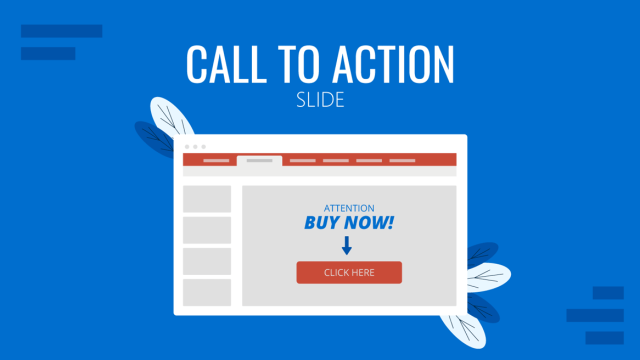
Filed under Design • May 29th, 2024
How to Create Effective Call to Action Slides for Presentations
When concluding a presentation, it’s essential to prompt attendees to take action. This is where a specific slide type, the call-to-action slide or CTA slide, comes into play. Depending on your context, this slide can incorporate various graphical elements, such as compelling images, charts, or diagrams, to evoke emotions or simply be attractive with information […]

Filed under Business • May 14th, 2024
The Sales Process Decoded: Main Steps and Responsibilities Explained
The sales process is a series of strategic steps your company takes to convert a prospect into a buyer. In this article, we break down the main component of the sales process and what happens at each stage
Leave a Reply
- Product overview
- All features
- Latest feature release
- App integrations
- project icon Project management
- goal icon Goals and reporting
- asana-intelligence icon Asana AI
- workflow icon Workflows and automation
- portfolio icon Resource management
- my-task icon Admin and security
- list icon Personal
- premium icon Starter
- briefcase icon Advanced
- Goal management
- Organizational planning
- Project intake
- Resource planning
- Product launches
- View all use cases arrow-right icon

- Help Center
- Asana Academy
- Certifications
- Work management hub
- Customer stories
- Get support
- Developer support
- Customer Success
- Project plans
- Team goals & objectives
- Team continuity
- Meeting agenda
- View all templates arrow-right icon
- Business strategy |
- 15 creative elevator pitch examples for ...
15 creative elevator pitch examples for every scenario
A good elevator pitch can be the difference between landing your next big opportunity or falling short of the competition. But the reality is, people want to have meaningful conversations without the forced sales pitch. So how do you pitch yourself during a job interview or client meeting with authenticity?
We’ve put together 15 creative elevator pitch examples that will help you nail your next client meeting or virtual networking event. Whether it’s your first time or you’re a seasoned professional, our examples cover any situation you might find yourself in.
Connecting goals to work effectively
Learn how to align your team's work with organizational goals. Discover strategies to ensure that every task contributes to reaching your objectives quickly and efficiently.
First things first: What is an elevator pitch?
An elevator pitch, also known as an elevator speech, is an opportunity to share a quick summary of yourself and your product offerings. But a pitch can also be your chance at making a real connection that you can use later down the road. It’s not always an immediate benefit, but you should be prepared for any scenario in which you could be giving an elevator pitch.
In reality, most people have given an elevator pitch whether they realize it or not. That’s because there are many different types of pitches—from interviews to new business opportunities. This includes situations where you need to "tell me about yourself" to recruiters or hiring managers. Therefore, preparing your next pitch becomes an important step in marketing both yourself and your company.
When it comes to figuring out who to deliver your pitch to, you should aim for the best point of contact, not just the highest point of contact. Choosing connections that are related to or interested in what you’re offering will give you a better chance at making your sale.
How long should an elevator pitch be?
One of the biggest unknowns about creating sample elevator pitches is how long they should be. In most cases, it will depend on what it’s about and who you’re pitching. A good rule of business etiquette is to make it as short as possible by carefully selecting the most important points.
A study conducted by Microsoft found that the average person has an attention span of around eight seconds, meaning you’ll have to fight for that undivided attention. That’s no small task. So when it comes to a great elevator pitch, aim to keep it around 30 seconds—though the exact length can vary depending on your industry and what you’re pitching.
When looking at pitch length based on industry, each one differs to some degree. Let’s take marketing for example. Your pitch opportunities will likely be to customers that come across your brand. And in that case, you have very little time to get your message across—whether it’s text, video, or imagery. But when it comes to sales, you may get the opportunity to expand your elevator pitch past 30 seconds. You will likely have plenty of networking opportunities where people are more than willing to listen to what you have to say. It really just depends on your medium and the audience’s eagerness to listen.
But what if you can’t cut your elevator pitch down to 30 seconds? It may seem like your brand is too complicated to distill down to such a short timeframe, but if you’re pitching to the right audience you shouldn’t have that problem. Make sure you pitch to people related to your industry or a tangential audience that will be able to interpret your offerings.
Whether you're pitching a new product, a startup idea, or your work experience to a potential employer, make sure you pitch to people related to your industry or a tangential audience that will be able to interpret your offerings.
How to write an elevator pitch
When it comes to writing an effective elevator pitch, it can be hard to decipher important facts from unimportant ones—this is why knowing how to effectively communicate in the workplace is important in the first place. For example, while it’s good to personalize your communication tactics wherever possible, it’s not necessary to give prospects an entire history lesson on your business. Only the most recent and relevant details should be included. To get started creating your own pitch, you first need to understand the basic components that make up any good elevator pitch.
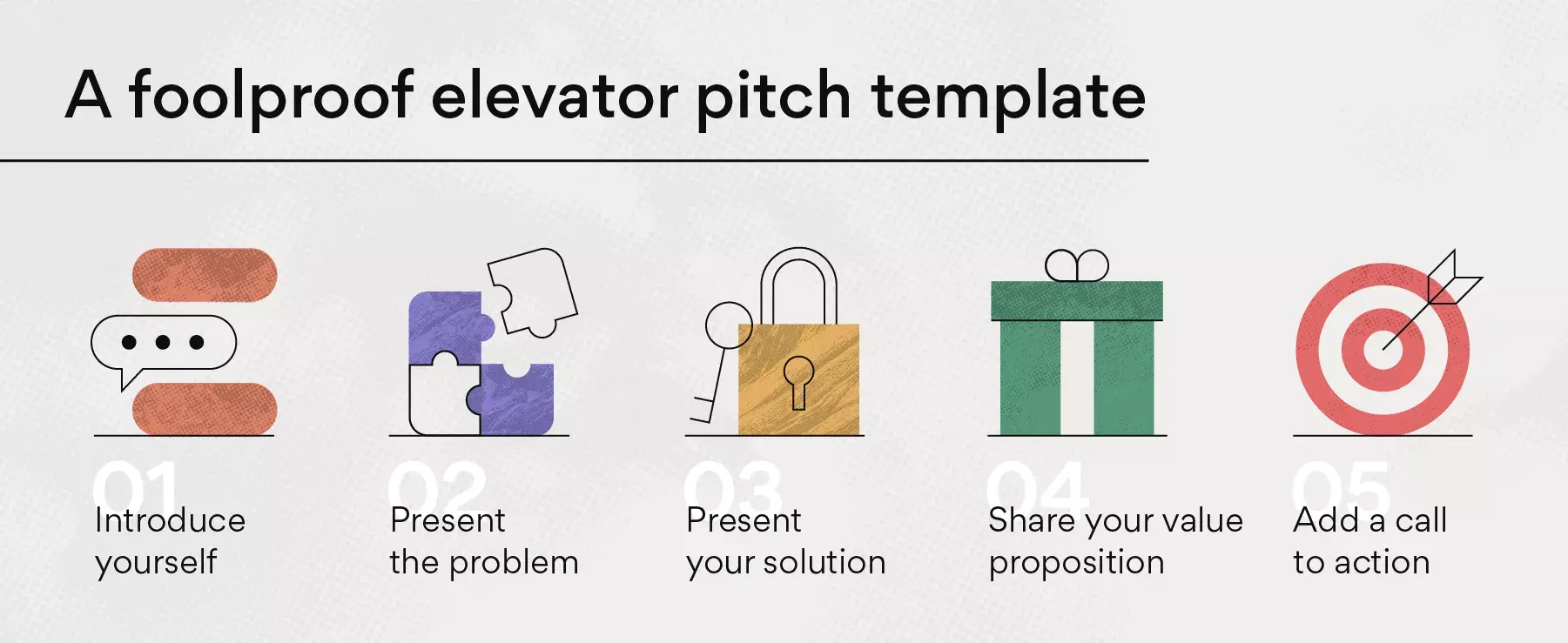
Step 1: Introduce yourself
All good pitches start with a short introduction. It could be as simple as stating your name and who you work for if those details apply. But the more personal you can make it, the more natural your elevator pitch will seem. Nonverbal communication skills like body language and eye contact are also an important part of a solid introduction. Here are a few tips to keep in mind when introducing yourself to a new prospect.
Greet your audience in a compelling way that's appropriate for the occasion.
Use a formal greeting for a business pitch or when meeting with hiring managers.
Opt for a more casual greeting for a fun event or informal networking opportunity.
For virtual business meetings and professional networking events, get creative with your introductions over video chat.
In virtual networking events, focus on making a strong first impression, as it can be more challenging than in-person meetings.
Consider starting with a lighthearted joke to break the ice, ensuring it's relevant to your target audience. This can be particularly effective at career fairs or when giving your elevator speech to recruiters.
Step 2: Present the problem
All solutions start with a problem. Whatever you or your business is trying to solve, it’s important to get the point across early on in your elevator pitch to set the theme for the rest of your speech. An example problem: coordinating work between teams is chaotic.
If possible, relate the problem back to your audience by using real-world examples. This will help make the problem more relevant and, hopefully, grab your audience’s attention. If your problem isn’t easy to explain, try using more than one example or a visual to really paint a picture for your audience.
Step 3: Offer the solution
If the problem is what draws the audience in, then the solution is what hooks them. This is your time to show them why they need your help. Here’s an example solution: Asana gives teams a system to organize and manage work so they know what to do, why it matters, and how to get it done.
The solution is arguably the most important part of an elevator pitch, so spend time perfecting it. If you’re pitching for a business, it’s likely the quick solution pitch has already been created. But again, it’s always better to personalize your pitch. So don’t be afraid to tweak it to fit your audience. If pitching for yourself, talk about the unique skills you’ve developed and why they would be beneficial to your prospect.
Step 4: Explain your value proposition
Now that you’ve piqued your audience’s attention, it’s time to seal the deal by explaining why your solution is better than anyone else's. An example value proposition is: Asana is the only platform that connects goals with the work needed to achieve them.
The value proposition differs from the solution by focusing on why your audience should use your solution over a competitor’s. If you don’t have that answer just yet, perform a competitive analysis to compare your offerings or look to your executive summary.
If you're pitching during a job search or to build your network, your value proposition should highlight your unique skills, career path, and how they align with the company's or individual's goals.
If your market is extremely niche and you don’t have a clear differentiator or significant competition, look to communication and interface capabilities. Consider why your idea or solution is original enough that someone would want to use it.
Step 5: Engage the audience
While most of the hard work is done, it’s important to engage your audience with a compliment or question before you part ways. Always err on the side of being genuine rather than delivering a scripted goodbye.
There is no right or wrong way to engage your audience. While ending with a question can create a dialogue between you and your audience, a genuine compliment can go a long way. Think about what made you want to pitch them in the first place and use that to end the conversation. Don't forget to include a clear call to action, whether it's scheduling a follow-up meeting, exchanging business cards, or connecting on LinkedIn. Lastly, don’t forget to swap contact information, such as a business card, if you don’t already have it.
Elevator pitch template
Now that you know the basic components of a pitch, the next step is creating your very own elevator pitch. This template can work for just about any situation, from a job interview to pitching a small business or startup. That’s because we analyzed some of the most famous templates from industry experts—from Harvard research to Guy Kawasaki’s art of pitching—to create the best elevator pitch template that will work in any situation.
Plug your information into our elevator pitch template to draft a quick speech. While you won’t necessarily recite it word for word, it’s a great model to keep in mind in case you find yourself in a position where you’re not prepared with a personalized pitch.
Whether you’re looking for a pitch template for a job interview or for pitching your business, this template is a foolproof example for any situation you might find yourself in.
General elevator pitch template
Use our elevator pitch template to start constructing your speech by adding statistics and personalized greetings where needed. This template incorporates the four parts explained above to hit all of the important details of a good elevator pitch.
Introduction : “Hi I’m [name], a [position title] at [company name]. It’s great to meet you!”
Problem : “Since you work with [company name or industry] I figured you’d be interested to know that [problem + interesting statistic].”
Solution : “The great part about working at [your company’s name] is that we’ve been able to fix just that problem by [solution].”
Value proposition : “In fact, we’re the only company that offers [value proposition].”
CTA : “I think our solution could really help you. Are you available this week to speak further on this?”
Don’t be afraid to change up your pitch template based on your personality and professional expertise. We’ve also included personalized 30-second elevator pitch examples below to inspire personal facts you can add to create a more engaging speech .
30-second elevator pitch examples
Let’s dive into the best 30-second elevator pitch examples to help you create a pitch that’s both engaging and informative. Our examples take inspiration from the four elements included in the template above, to demonstrate how you'd pitch project management software to increase productivity . Try a few or try them all to find one that best fits your personality and value proposition.
Example 1: Short and sweet
This example is one of the most common you’ll come across. That doesn’t necessarily mean that it’s the best, but it’s a great example of a quick and easy pitch that fits almost any situation. When working on this type of elevator pitch, be sure to keep it as short and to the point as possible. Try to stick closely to the 30 seconds or less rule since the point is to be brief and transparent.
The problem is that work is chaotic no matter what industry you’re in or how good you are at your job. But a good project management software can help improve productivity and communication. I haven’t missed a deadline in years. If you’re interested in how it can help your team, give me a call and I can take you through some numbers.
Example 2: Relatable over reliable
Sometimes the best way to grab your audience’s attention is to reel them in with a personal anecdote they’ll relate to. While it’s still important to drive home your solution, this approach puts more weight on making a personal connection rather than an immediate sale.
It’s so great to finally meet you. How is business going? I heard you’ve been struggling with communication issues. My team and I struggled with that too. It wasn’t until we added project management software into our routine that we really saw an improvement in teamwork and overall communication. I hope you find a solution that works for your team.
Example 3: Savvy with stats
Start your pitch off with a hook by dropping an attention-grabbing statistic. It’s important to have hard data to back up your statistics to ensure their accuracy before pitching. When it comes to a statistics pitch, it’s a good idea to come full circle at the end and connect how your solution can help solve that statistic.
Did you know that despite having more ways to connect remotely, 60% of workers’ time is spent on work coordination with just 26% spent on skilled work and 14% on strategy? No wonder teams need help with project management. Implementing project management tools can decrease time spent on work coordination and help increase skilled work.
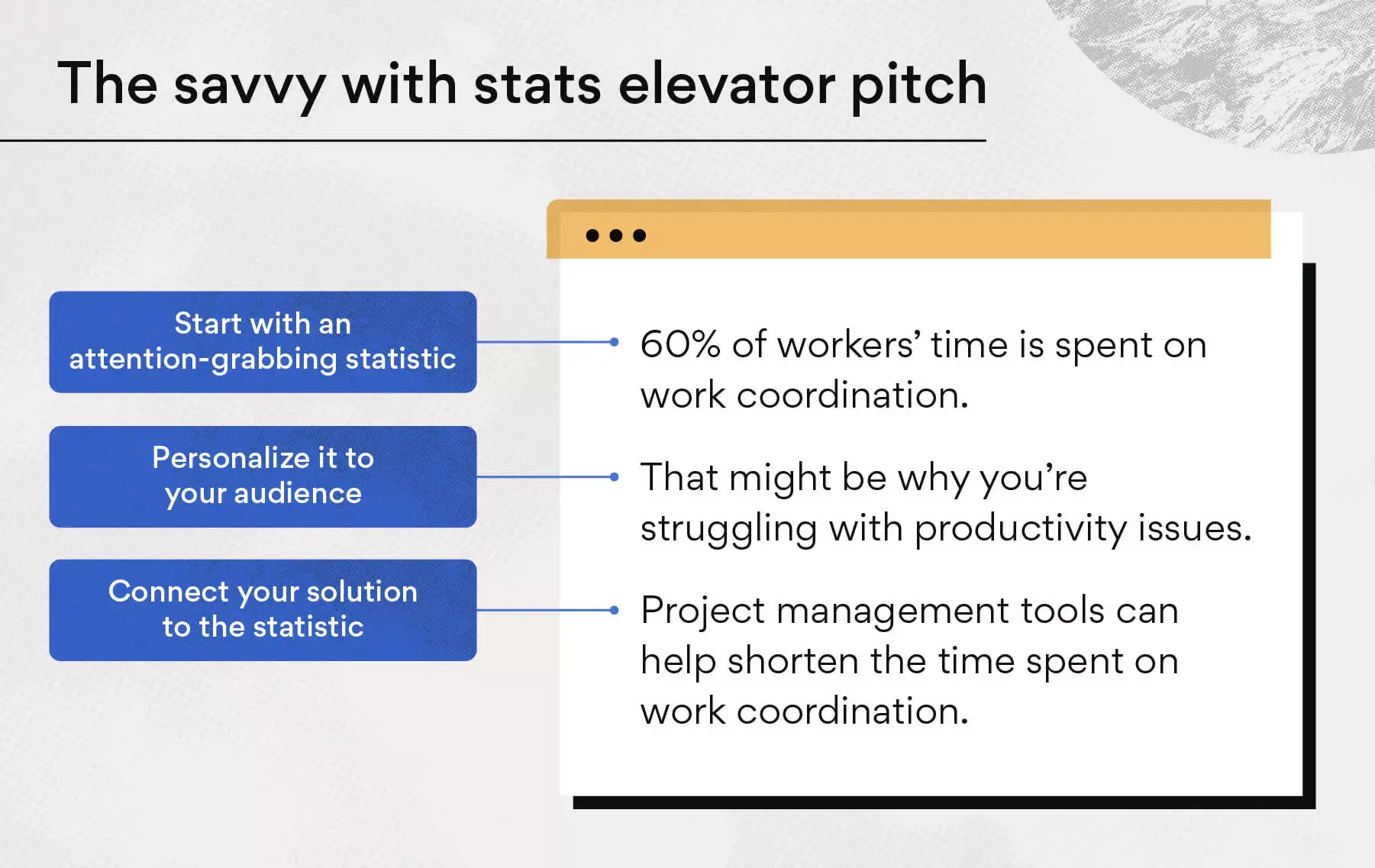
Example 4: Question everything
This example uses questions to make your pitch easily comprehensible. It also forces the audience to join in on the conversation rather than just presenting them with a speech. Try starting and ending with a question that makes the audience think about your pitch long after you leave the room.
Do you ever feel like you spend too much time on work about work? I’ve talked to so many people who share the same frustrations. I used to work long hours every day just trying to catch up. But do you know what? Ever since we started using project management software, I've been able to get so much more work done. Have you tried anything similar in the past?
Example 5: Comedic twist
If your pitch isn’t about a serious topic, you can add comedic twists to engage the audience. This is especially useful if giving a presentation. Add a GIF or quick funny clip in between slides to lighten the mood. If using this example, be sure it fits the occasion and tone of your company.
Did you know that the average person can only pay attention for eight seconds? That’s not even long enough to place my coffee order in the morning. Maybe that’s why my barista always gets it wrong. But seriously, I think that’s why so many companies struggle to hit deadlines.
Example 6: Tell a story
Use customer testimonials or your own personal story to paint a picture for the audience. This can be especially helpful if your topic is hard to explain in 30 seconds or less. Telling a story is a great way to add a relatable twist.
We have a customer that transitioned to a fully remote workforce this year and needed help making sure deadlines were met. With our help, they were able to get up to 10% of their time back in their day and focus on more important things like strategic planning.
Example 7: Emotionally driven
While this type of pitch may be more difficult to create, you have a better chance of winning over your audience if you can make your pitch emotionally driven. It’s also more likely they’ll be willing to share the experience with someone else down the road. It’s important to keep the emotions on the lighter side to prevent the conversation from steering too dark. Here is an example to inspire your own speech.
It may seem like any other tool, but when you look closely it really is helping teams connect. And not just that, but it’s helping cultivate teams that actually enjoy working together on new projects. That’s something that’s hard to come by, but something everyone is looking for.
Example 8: Write it first
While most speeches start by writing a general outline, you can opt to write the entire pitch from start to finish. This tends to create a thought-provoking and poetic flow once you do present your pitch. You’ll have to memorize this pitch, so practicing is a key element to this strategy.
Hi, my name is Kelly! It’s great to meet you. You work for Apollo Enterprises, right? I’ve heard a lot about them. I actually heard that you’re looking for project management help. In my experience, any organization—whether sales or suppliers—needs help coordinating work and team communication. Work can be rather chaotic, especially now, without it. That’s why we’ve created a software tool that helps both individuals and teams organize their projects and communications all in one place. Have you ever thought about using something similar?
Example 9: End with a one-liner
Making a grand exit doesn’t come easily, but if you can pull it off your audience is sure to be impressed. Stay away from cliche one-liners and make your closing authentic to you. The point here is to leave them with a thought that they’ll remember after the meeting is over. Consider sharing a surprising statistic or question relevant to their business.
Over one-quarter (26%) of all deadlines are missed each week because of a lack of clarity. But with the right project management tools, that number could be much lower. So the question is, can your business afford not to use project management software?
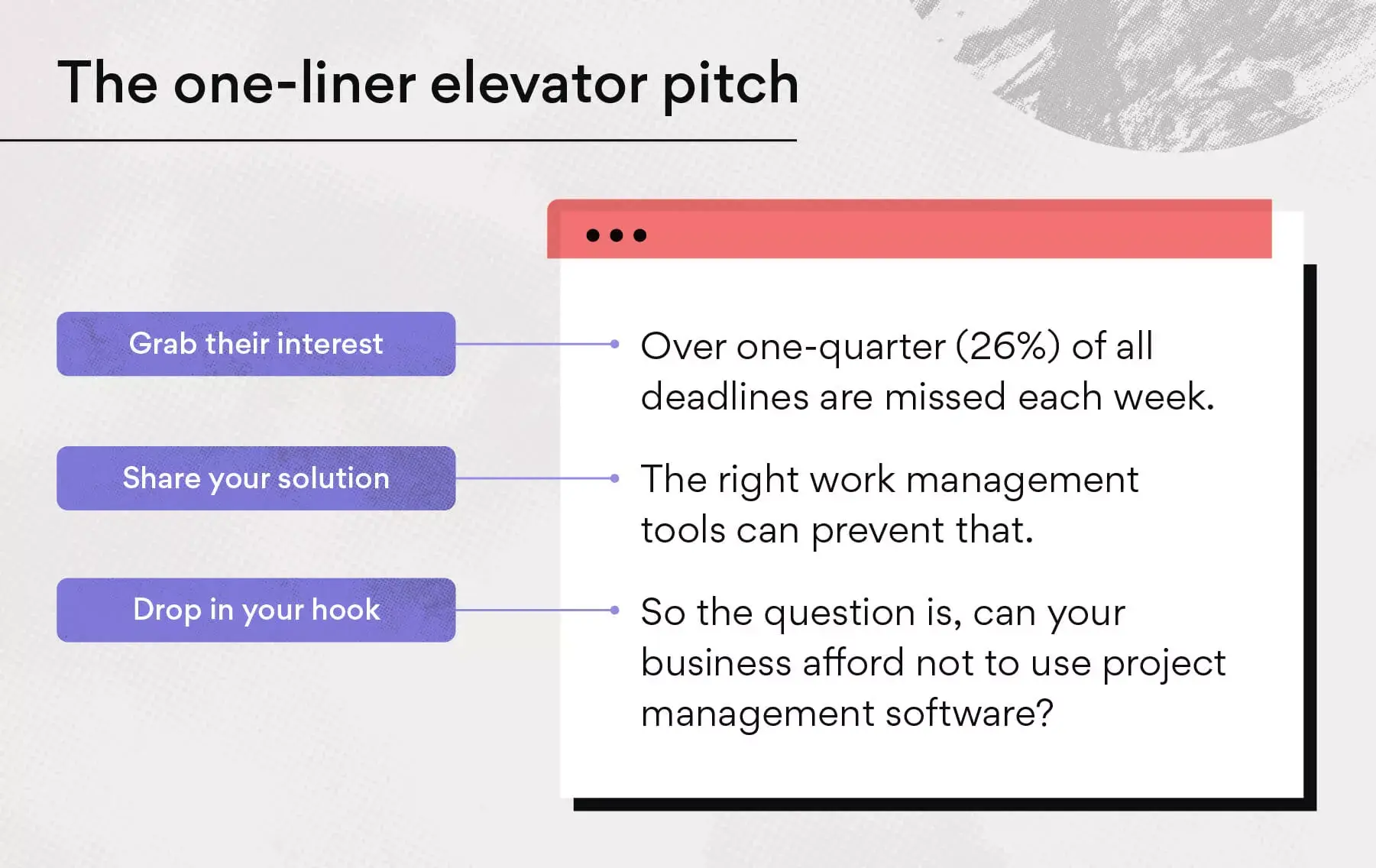
Elevator pitch examples by scenario
Now that we’ve covered the types of pitch examples, let’s dive into example elevator pitches for different scenarios. Whether you’re pitching for your business or yourself, you can use an elevator pitch to organize your thoughts and prepare for the real deal. Let’s look at key tips for any situation you may find yourself in.
Example 10: Networking event
A networking event is probably the most common scenario you’ll run into. And with the new virtual-first culture, it may be even more challenging to make meaningful connections over video chat. That’s why it’s so important to prepare an elevator pitch that’s compelling no matter where you’re pitching it from. While most salespeople pitch casually in this environment, you may get the opportunity to meet an important executive. In which case, you’ll want to be prepared with a versatile pitch template.
Great to meet you, I’m Kelly with Apollo Enterprises. We’ve been able to improve productivity and collaboration for teams all over the world. If you ever need help with project management, just reach out. I think we could make a huge impact on your company. I’ll make sure to keep your contact information handy as well.
Example 11: Job interview
Looking for a new job or have career fairs coming up? Most interviews—whether with human resources, a recruiter, or a hiring manager—start with some form of the phrase, “Tell me about yourself.” This is an opportunity for job seekers to briefly explain themselves and their professional experience using industry buzzwords and key skills. Having an elevator pitch ready can ensure that you’re prepared when the opportunity presents itself.
I’m Kelly, a specialist at Apollo Enterprises. I chose a career in project management because I had a passion for it, and now I can proudly say that I’ve been able to make a real difference in people’s lives. That’s why I’m looking to continue my career with an employer who shares those same values. I know my unique skills can make a big impact at your company because I’ve proven my results with a few key projects.
Example 12: Formal meeting
You’ve landed the meeting, congratulations! Now is the time to create a formal elevator pitch to really get them interested. When presenting a formal pitch, a presentation can be a great addition to traditional elevator speech examples. But whether or not you choose to create a presentation, this meeting is about selling your product in the most professional way possible. So dress the part and don’t forget your unique selling proposition.
I took a look at your current productivity figures and noticed an opportunity for improvement. With our project management software, you could get back up to 10% more of your workday. Not only would that mean more work getting done, but it would also have a positive impact on the overall success of your business. Not to mention, our tool is the only one in the industry that has goal capabilities to ensure teams stay on track.
Example 13: Sales pitch
Professionals often pitch traditional sales jargon, but the real key is creating a human connection while lightly sprinkling in what you’re selling. Start with a personal story or light-hearted introduction instead of the typical sales presentation. You can also prepare by creating sales team goal templates to ensure your team is on the same page.
Our team really struggled to transition to a remote workforce. Communication wasn’t organized and people struggled to find the correct information to complete projects. But, thankfully, we found a solution to our problem. Implementing project management tools not only improved productivity but also improved overall teamwork. Every company prefers different tools, but I can say without a doubt that our software was the best at connecting goals with the work needed to achieve them.

Example 14: Social introduction
Now, more than ever, professionals are choosing to meet virtually rather than face-to-face. Whether you’re chatting over LinkedIn or have a virtual meeting set up, it’s important to make your pitch personal and use clear visuals to help sell your point. Here’s a great example of a social media pitch.
Thanks for connecting! I noticed that your competitors are outperforming you when it comes to year-over-year growth. I took the liberty of doing a competitive analysis and didn’t find any outlying problems. I’m wondering if it could be an issue with productivity. How has the transition to remote work been? If you’re interested, I could run you through some productivity figures if you were to add project management tools to your current processes.
Example 15: Entrepreneurs and business owners
Pitching to a business owner is much different than pitching to an executive. They can be harder to sell because they are often hesitant about new investments. The most important tip is to use examples as they pertain to the business when explaining a problem and solution.
I love your products at Apollo Enterprises. I’m a huge proponent of your mission. I did realize that there may be some opportunities to improve productivity and collaboration internally. Have you ever considered project management software? I think it could have a big impact on business growth now or even down the road.
4 tips to perfect your elevator pitch
In addition to creating the perfect elevator pitch, you should also work on sprucing up your delivery. There’s nothing worse than sitting through a boring speech, so make sure yours is anything but. From posture to tone, there’s a lot you can practice to make sure you look professional and knowledgeable. Consider these four tips when trying to nail a successful elevator pitch.
1. Stick to your outline
To prevent getting off-topic, it’s important to stick to your outline at least to some extent. While you don’t need to recite it word for word, it’s best to memorize the majority of your pitch. That way you won’t need to worry about checking your notes.
2. Speak slowly and clearly
Many professionals tend to talk quickly when they’re nervous—hey, we’re only human. But it’s important to enunciate and speak slowly so the audience can understand you. This is especially important when presenting over video chat. But try not to slow yourself down too much or you’ll go over your allotted time.
3. Record your pitch
Record yourself reciting the pitch to work on any areas that need improvement. Practice your pitch a handful of times by playing the recording back and working out any pain points. A couple of key areas to focus on are speed and tone. It’s better to sound overly energized rather than monotone.
4. Practice, practice, practice!
There’s nothing more effective than practicing your pitch until you’re able to recite it in your sleep. If possible, practice in front of friends and family to get constructive feedback on how you can make your pitch even better. Even if you have years of experience, you can never go wrong with being overly prepared.
Common elevator pitch mistakes to avoid
Even with the best elevator pitch examples at your disposal, it's easy to fall into common pitfalls. Here are four mistakes to avoid when crafting your pitch:

1. Rambling and using too much jargon
One of the biggest mistakes in delivering an elevator pitch is exceeding the optimal amount of time and filling it with industry jargon. Remember, the best elevator pitch is concise and easily understood. Avoid technical terms that might confuse your audience, whether they're hiring managers, potential clients, or fellow professionals at a networking event.
2. Not communicating your value proposition in a compelling way
Your elevator speech should quickly and effectively convey your unique value. Whether you're job hunting or pitching a new business, clearly articulate what sets you apart. This is especially crucial when addressing a potential employer or investors. Your value proposition should be one of the key points that stick with your audience long after the conversation ends.
3. Not tailoring your pitch to your target audience
A one-size-fits-all approach rarely works for an elevator pitch. Tailor your message to your specific audience, whether you're at a career fair, a networking event, or even crafting cover letters. For instance, if you're pitching to a nonprofit, focus on impact and mission alignment rather than just profitability.
4. Forgetting to include a call to action
An effective elevator pitch should end with a clear next step. Whether it's exchanging business cards, setting up a follow-up meeting, or inviting them to subscribe to your newsletter, always include a call to action. This gives your audience a concrete way to continue the conversation and build your network.
Elevate your first impression with an elevator pitch
An elevator pitch is a chance to show off your strengths and pitch your solutions. While it may sound nerve-wracking, using the 15 elevator pitch examples above will help you develop your own method using personal tidbits that tie into your innovative solutions.
While your pitch is an important part of leveling up your business, there are many avenues you can take to achieve growth. One of those ways is by determining whether project management vs. work management tools are right for your team. Not only will they help connect your team members, but the right tools and software can also help your organization set strategic goals. That means more time spent on bigger projects to help your business reach next-level growth.
FAQ: Writing the perfect elevator pitch
What should an elevator pitch say?
An effective elevator pitch should concisely communicate who you are, what you do, and your unique value proposition. It should highlight your skills, experience, or product offering in a compelling way. For those in a job search, your pitch should answer the interview question "Tell me about yourself" while focusing on career goals that resonate with your target audience.
What are the three C's for an elevator pitch?
The three C's for an elevator pitch are Clear, Concise, and Compelling. A clear pitch uses simple language without jargon. Concise means keeping it brief, ideally 30 seconds or less. A compelling pitch is interesting and relevant, encouraging further conversation, whether you're networking or in a job search.
How can I improve my elevator pitch?
To improve your elevator pitch, practice in front of a mirror to refine your delivery and body language. Record yourself to identify areas for improvement. Seek feedback from others and continuously refine your pitch. Tailor it for different scenarios, from job interviews to networking events. Regular practice will make your pitch more natural and effective in your job search or business endeavors.
How do I prepare for unexpected elevator pitch opportunities?
To prepare for unexpected elevator pitch opportunities, have a basic pitch ready that you can adapt on the spot. Keep business cards handy and stay informed about your industry. Practice regularly so your pitch feels natural, even during a short elevator ride. Aim for an authentic conversation tailored to your audience, whether at a networking event or during an unexpected professional encounter. For product or service pitches, focus on quickly capturing interest to turn listeners into subscribers or leads.
Related resources

4 types of concept maps (with free templates)
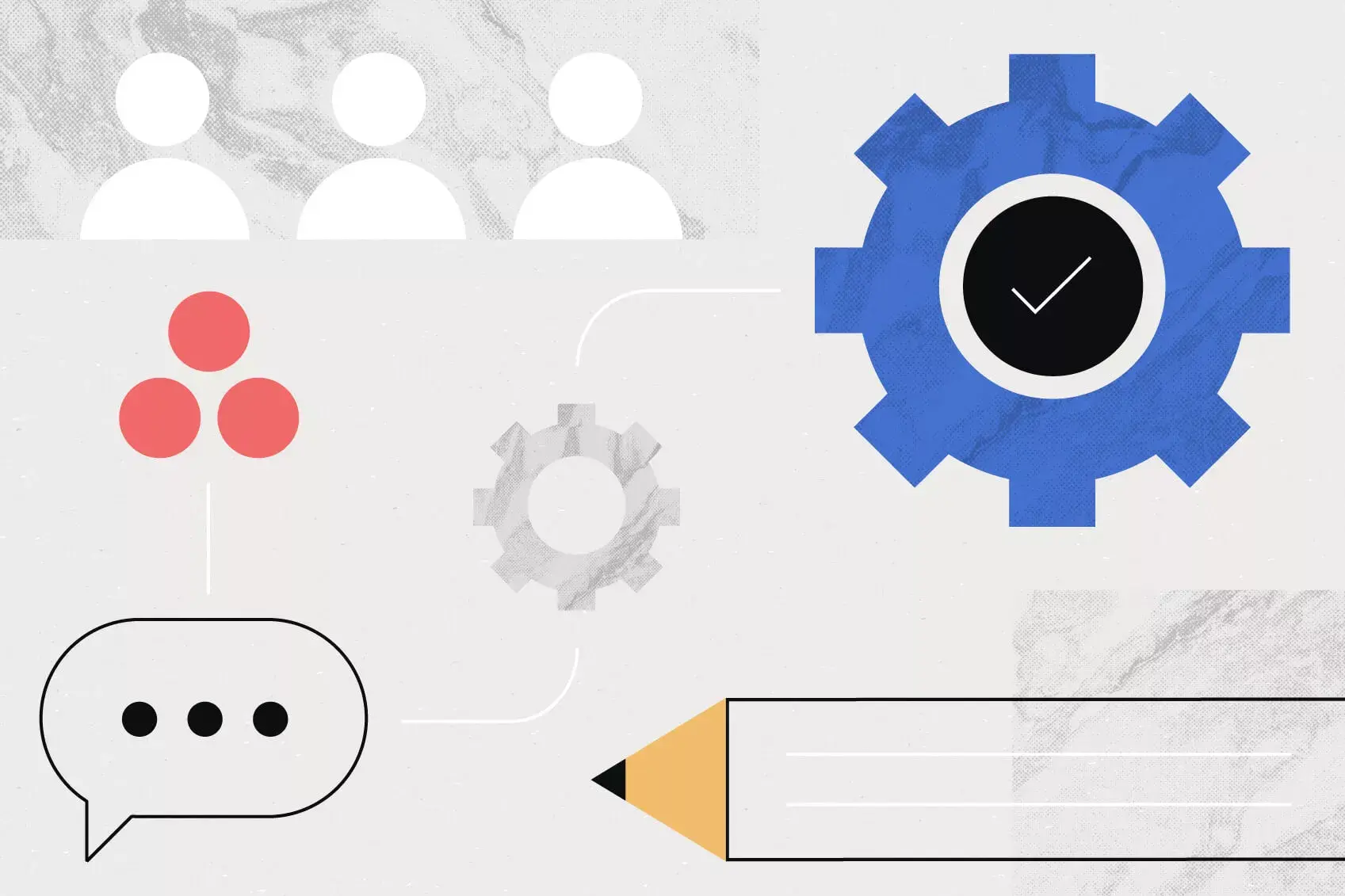
6 tips to build a strong organizational culture

How to use benchmarking to set your standards for success

How to scale retail management operations with Asana
23 Elevator Pitch Examples to Inspire Your Own [+Templates & Expert Tips]
Updated: May 06, 2024
Published: August 08, 2017
Whether you're introducing yourself at a networking event, telling new colleagues about your business, or pitching to another professional — you want to capture attention and get it fast. In situations like these, you need a short and easy-to-grasp explanation of your company and its products, like an elevator pitch.

In this post, we'll discuss what an elevator pitch is, review some helpful examples, see some elevator pitch templates you can reference, go over some elevator pitch best practices, and cover some key mistakes you need to avoid when delivering one of these speeches.
Let's dive in.

Table of Contents
What is an elevator pitch?
Elevator speech example, how to write an elevator pitch, elevator pitch templates, 30-second elevator pitch examples, elevator pitches from real sales leaders, elevator speech best practices, what not to do in an elevator pitch.
An elevator pitch — also known as an elevator speech — is a short, memorable description of what you do and/or what you sell. The goal is to earn a second conversation, not to convince the person you're talking to that they should hire you or buy your solution.
An elevator pitch is never an opportunity to close a deal. It‘s an opportunity to close more of your prospect’s attention and time. It's a quick introduction to you, your company, and how you can help your prospect.
Hi, I‘m an account manager with Vacation Locator. We help travelers across the world plan their perfect holiday based on their interests, budget, and location preferences. With travel experts assigned to each account, we find the best deals and most unique experiences for each client, so they can enjoy their vacation, instead of stressing out about planning it. On average, we’re able to save travelers up to 30% on expenses such as hotel and airfare.
.png)
Download Now: Free Elevator Pitch Templates
E-pitch templates to better sell your product, fund your business, or network.
- 4 Fundraising Pitch Templates
- 2 Networking Pitch Templates
- 2 Sales Pitch Templates
Download Free
All fields are required.
You're all set!
Click this link to access this resource at any time.
When to use an elevator pitch?
You can pull your elevator pitch out at functions like networking events or conferences, over interactions like warm calls, and even in job interviews or at career fairs. Keep your elevator pitch goal-oriented — for instance, "I help companies like yours increase production by up to 30% without additional cost . " — and always end with a business card or request to connect on LinkedIn.
If you‘re curious about what an elevator pitch should look like, or simply ready to jumpstart the pitch creation process, download the templates below. We’ve compiled several types of templates — from sales pitches to funding requests.
No matter which type of pitch you‘re delivering, keeping things concise is key. You don’t want to waste your prospect‘s, investor’s, or fellow professional‘s time. With that in mind, let’s take a look at how much time should you spend on an elevator pitch?
How long should an elevator pitch be?
An effective elevator pitch is meant to be no more than 30 seconds, just like the length of time you ride in an elevator. You want to keep your words easily digestible, so avoid trying to get too deep into specifics as it can drag on the conversation — and lose your prospect's attention.
You should have an effective elevator pitch prepared before you need it since you have such a short window to deliver it. Your pitch needs purpose, flow, and a hook to reel in attention if you want to get the kind of mileage you need out of it in 30-ish seconds.
Let's take a closer look at how to put one of these pitches together.
1. Use elevator pitch templates .
.jpg?width=1060&height=1380&name=Growth%20Strategy%20Template%20(18).jpg)
Download Free E-Pitch Templates
Use these templates to help structure pitches for three key audiences: prospects, investors, and potential network connection — making the elevator pitch creation process easier, freeing you up to focus on selling, crushing quota, and living your best life.
Let's dive into the ins and outs of fleshing out an elevator pitch of your own.
2. Introduce yourself.
The value of a personal introduction in an elevator pitch is multifaceted. For one, it gives your prospect some pretty mission-critical context — you won‘t get too much mileage out of an elevator pitch if they have no idea who you are or who you’re with.
Second, it can make the whole experience a bit more approachable. You don't want things to be too rigid or imposing when you pitch — a friendly introduction helps set the stage for a more natural engagement.
Bear in mind — you need to know what your prospect needs to know . What I mean is that you have to be mindful of how much information you‘re sharing as part of your introduction. You don’t want to get lost, ramble, and share more information than your prospect needs to know. Get it?
Effective elevator pitches are delivered in a tight window — you don‘t want to waste time rattling off details like how long you’ve worked at your company, what job you had before, or how much you like working for your employer.
Stick to the essentials, be friendly, and get on with the pitch.
3. State your company's mission.
Want me to let you in on some next-level, mind-blowing insight? Ready? Here we go — you need to know what your business does if you're going to pitch it effectively. Revolutionary stuff, right?
Seriously though, you want to include some insight about your business — and a lot of the time, that means briefly speaking to its mission and goals. Including a section where you give a thoughtfully tailored reference to your company identity can give a prospect valuable context and develop a little trust on a dime.
You don‘t have to give a comprehensive rundown of every project you’re working on or fondly reminisce about the team retreat where you picked up trash on the local beach. It can be as simple as something like, “I'm a sales rep at Better Than the Rest Cable. We help hotels across the U.S. pair with the perfect cable provider and plan for their region and needs.”
That description is both succinct and sufficient. It covers the necessary bases without getting too deep into the weeds. If you were to be cut off after these two sentences, the prospect would still know exactly who you are and what your company does. You know — the stuff your prospect needs to know.
4. Explain the company value proposition.
This might be the most important base to cover. A prospect isn‘t going to be interested in a solution that they can’t see the value in, so naturally, you need to be able to articulate a compelling value proposition in your pitch.
Unless you're at the forefront of some sort of technological revolution, your product or service exists in a competitive landscape — so your prospect is bound to have some options. Why should they choose you?
You need to provide a sentence or two that covers why your product or service is worth it — why your current customers are so happy with you. Here's what that could look like:
“I'm a sales rep at Better Than the Rest Cable. We help hotels across the U.S. pair with the perfect cable provider and plan for their region and needs. With regional experts assigned to each account, we help hotels identify the most cost-effective and guest-delighting cable plan for them.”
In one sentence, you‘ve told the prospect what sets you apart and how you can bring them value. You’ve likely piqued their interest, but how can you really grab their attention? Keep reading.
5. Grab their attention with a hook.
You‘ve spent the pitch up to this point lining them up, now knock them down. Give them the bit that’s going to prompt that second conversation — hit them with the hook.
That can come in the form of an enthralling story about a customer, some exhilarating information about your company's founders, a fascinating statistic about your offering, or something else that's neat and engaging to round things out and keep them interested.
Let‘s finish up the pitch we’ve been running with with an attention-grabbing statistic.
“I‘m a sales rep at Better Than the Rest Cable. We help hotels across the U.S. pair with the perfect cable provider and plan for their region and needs. With regional experts assigned to each account, we help hotels identify the most cost-effective and guest-delighting cable plan for them. On average, we’re able to save hotels up to 25% on their annual cable bills.”
6. Make sure your pitch is more conversational and less “sales-y.”
According to Patrick Beltran , Marketing Director at Ardoz Digital , you want to "[a]void sounding too sales-y. In my experience, people often shy away from elevator pitches that feel like a typical sales pitch. Your elevator pitch should come across more like a casual chat than a sales pitch. The aim is to spark interest, making the listener curious to learn more, not to seal the deal immediately.
"To make your pitch sound conversational, use a relaxed tone and steer clear of jargon. For instance, rather than saying ‘We offer cutting-edge solutions,’ say ‘We provide innovative solutions.’
"And instead of aggressively promoting our brand, we suggest ‘We’re looking to work with companies to address some of their marketing challenges. Perhaps you’d be interested in exploring this opportunity?’ "
7. Keep it simple and focused.
Gauri Manglik , CEO and Cofounder of Instrumentl , says, "The most important tip I can offer for creating and delivering an effective elevator pitch is to keep it simple and focused. Have one clear message or key insight you want to convey and structure your pitch around that.
For example, if you have a new product, focus on articulating the core problem it solves and how it uniquely solves that problem. Say something like, ‘We’ve developed a new tool that helps sales teams reduce the time spent on administrative tasks by over 50% each week. By streamlining CRM data entry and reporting processes through an intuitive mobile interface, account managers can spend less time pushing paper and more time building key relationships.’
A simple, focused message like this, with one relevant example or proof point to bring it to life, is all you need for an initial elevator pitch. Resist the urge to cram in too many details or try to explain everything your business or product does.
You have 30 seconds; one clear message is enough to spark interest for follow-up. With practice, a simple pitch can become a compelling story that fuels a meaningful first conversation. Keep it short — make it count."
8. Read and edit the pitch.
Once you have everything written out, read it aloud to make sure it sounds natural. Overly rigid, borderline-robotic pitches are rarely compelling. If it seems too stiff and formal, go back to the drawing board — at least a little.
Ideally, this pitch will be a prelude to a professional conversation — so striking a balance between professional and conversational with your pitch is in your best interest.
Now that you know how to write an elevator pitch, download HubSpot's eight free elevator pitch templates to put your learnings into action. These templates can be used to make a sale, start networking, or jumpstart a deal for business capital.
Featured Resource: 8 Free Elevator Pitch Templates
.jpg?width=428&height=557&name=Growth%20Strategy%20Template%20(18).jpg)
Our templates follow established best practices for elevator pitches. Each one includes:
- A personal greeting: Start every pitch by establishing a human connection and making your prospect feel seen and heard.
- A statement of your company's mission: Your mission can be blended with your value proposition and vice versa. But this piece of information is essential to get your prospect's buy-in, quickly.
- A hook to get your audience's attention: The hook can be as simple as a probing question or a highly personalized statement that‘s been tailored to your prospect’s needs. Either way, the hook will often seal the deal.
- A real example: See the template in action by reading a filled-out example, allowing you to visualize what your pitch may look like as you refine and edit it.
Using these templates allows you to save precious time and focus on the essence of the pitch instead of minute details, such as how to start it off or how to organize it. Your prospect's time is valuable, and so is yours.
If you're looking for some inspiration, look no further. The following elevator pitch examples illustrate different ways to describe what you can offer in 30 seconds or less.
1. An Attention-Grabbing Question
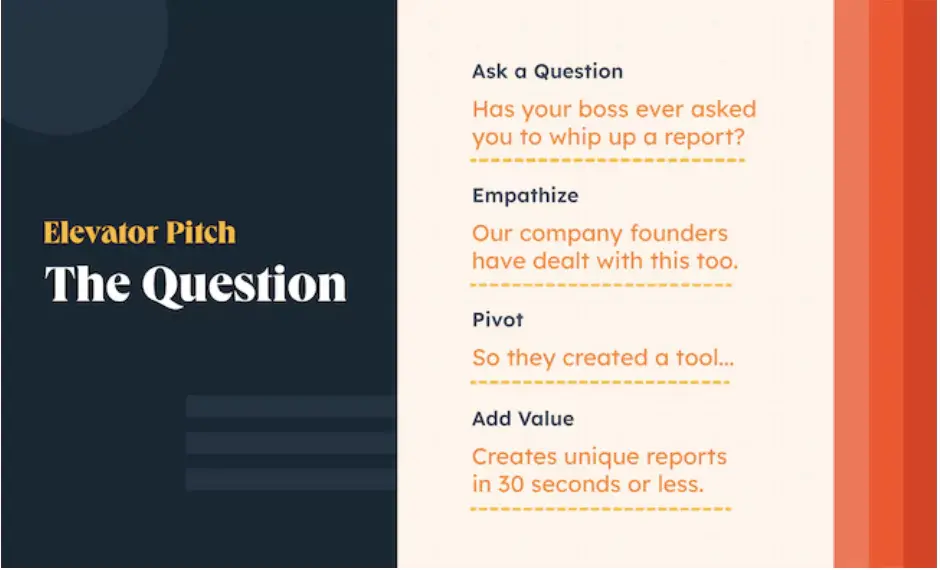
And like the previous one, it speaks to a “common but specific” pain point for the prospect on the other side of the pitch, covering an issue that many (if not most) marketers deal with consistently — and the “look at how many of your peers I talk to every month” element supports that.
And finally, it ends with an accessible but vivid metaphor about how efficient the resource is. I‘ll go out on a limb and assume that most prospects have poured a cup of coffee in their lives. It’s a frame of reference that's equal parts relatable and engaging — in short, it works.
3. The Surprise Ending
You want to know how many leads from your webinar campaign became customers versus leads from your trade show booth. But only customers who bought two products — and weren't already in your database.
How long would it take you to create that report?
If you had AnswerASAP, a data and reporting tool, you'd already know. It creates reports in a matter of seconds.
Holy heck! My goodness! What a twist! Bet you didn't see that ending coming — and neither will your prospects!
Okay, that might be overkill, but still, this kind of pitch works — for a few reasons. For one, it starts with a relatable approach. It runs through a “common but specific” scenario that businesses in the prospect‘s industry likely deal with. That shows that you’re familiar with a prospect's space, giving you some instant credibility.
From there, it offers an engaging, cheeky way to plug your solution. You raise a pressing pain point and immediately position your offering as the best way to solve it. It's slick, creative, and fun — taken together, those elements give you some serious staying power.
4. An Outlandish Stat
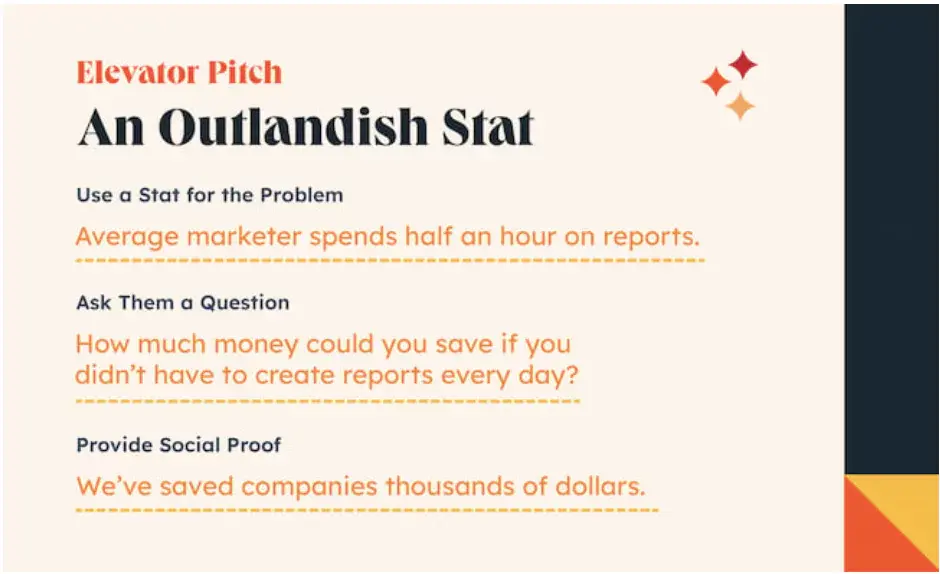
Dan Ponomarenko , CEO of Webvizio , offered this pitch:
“At Webvizio, we streamline web project management for digital teams, making collaboration seamless. Our platform allows you to visualize changes, communicate in real time, and manage feedback efficiently — all in one place. We eliminate the clutter of back-and-forth emails, so you can focus on what you love: creating. Interested in simplifying your project processes and enhancing team productivity?”
2. "Deliver a clear tech talent solution with EchoGlobal Tech . "
Lou Reverchuk , Co-Founder and CEO of EchoGlobal Tech , offered this pitch:
“Hello, I‘m Lou, representing EchoGlobal Tech, where we bridge the gap between innovative tech projects and top remote software developers. At EchoGlobal, we understand that the right talent makes all the difference. That’s why we guarantee no AI matchmaking and no juniors pretending to be senior devs. Always quality over quantity with us. Imagine having a dedicated expert who truly understands your project‘s vision and transforms it into reality. Let’s set up a time to discuss your hiring needs.”
3. "Simplify the insurance buying experience with Dundas Life "
Gregory Rozdeba , CEO of Dundas Life , offered this pitch:
“Imagine buying life insurance the way you shop online — quick, easy, and transparent. At Dundas Life, we streamline the complex process of finding the right insurance, making it accessible at your fingertips. With us, you‘re not just a policy number; you’re in control, informed, and secure. Let’s make insurance straightforward together.”
4. "Engage with real estate investment expertise with EZ Sell Homebuyers. "
Mike Wall , CEO of EZ Sell Homebuyers , offered this pitch:
“Looking to maximize your real estate investment? With over two decades of experience and a portfolio of over 30 properties, I provide tailored advice that turns real estate into real results. Let’s discuss how I can help you achieve your property investment goals today.”
5. "Enhance your online visibility with CodeDesign . "
Bruno Gavino , Founder and CEO of CodeDesign , offered this pitch:
“Hi, I’m Bruno from CodeDesign. We often see companies struggle to gain visibility in the digital space, losing potential revenue to competitors who dominate online. Our agency specializes in leveraging advanced data analytics and custom digital strategies to enhance your online presence, driving more traffic and increasing sales. Imagine what it would be like to see your business outperform competitors by simply optimizing your digital marketing. Let’s chat about how we can make that happen for you.”
6. "Illuminate spaces with quality lighting with Festoon House . "
Matt Little , Director at Festoon House , offered this pitch:
“Imagine transforming your space with lighting that‘s not only beautiful but also built to last. At Festoon House, we’re dedicated to crafting premium lighting solutions that elevate your style, enhance your ambiance, and stand the test of time. From modern chandeliers to industrial-chic fixtures, our products are designed to inspire and impress. Join the Festoon House family and let's brighten up your world together — one light at a time!”
7. "Solve food waste with RedBat.Agency . "
Gert Kulla , CEO of RedBat.Agency , offered this pitch:
“We're tackling the issue of food waste in restaurants. Our app allows diners to buy surplus food at a discount while helping venues reduce waste and generate extra revenue. This creates a win-win for businesses and customers looking to save money and curb food waste.”
8. "Elevate travel with JetLevel Aviation . "
Fahd Khan , Director of Marketing and Technology at JetLevel Aviation , offered this pitch:
“At JetLevel Aviation, we provide top-tier private jet charter services, ensuring fast, flexible, and seamless travel for high-profile clients. Unlike traditional charter companies, our bespoke solutions and access to a wide range of luxury jets guarantee that your travel experience is not just efficient but also tailored to your specific preferences and schedules. Let us elevate your travel experience to the next level.”
1. Keep it brief.
The purpose of an elevator speech is to be as brief as possible while capturing a prospect‘s attention. Try to stay under 60 seconds — including your introduction. Even if you’re delivering your elevator speech during a formal presentation, where you have time to elaborate if needed, keep the bulk of your pitch under sixty seconds.
If you don‘t, you won’t be able to use your pitch when you're chatting with prospects in situations with tighter time constraints — such as a tradeshow or a chance meeting.
2. Practice multiple times beforehand.
You may have written the most incredible elevator speech for your product, but if you hamper the delivery by misremembering or even forgetting parts of your pitch, it won't be an effective tool. Be sure to practice by yourself, with your manager, and with your colleagues.
The goal isn't just to memorize it, but to practice your tone, pace, and overall delivery.
3. Come prepared with additional materials.
When you‘re delivering your elevator pitch, be prepared to provide your prospect with what they need to continue the conversation. Whether that’s a business card, a brochure, or a short demo, carry all that you might need with you.
The elevator speech is your opportunity to begin a deal on the right foot and speed up the nurturing process. Typically, you might take weeks emailing a prospect before they're ready to schedule a meeting with you, but an elevator pitch speeds that work. You want to have the materials you need to keep the conversation going.
4. Be positive and enthusiastic.
It‘s essential to show your personality during your elevator pitch, but whether you’re a quiet, calm introvert or a charming, excitable extrovert, you should still convey positivity and enthusiasm.
You can use your body language and expression to keep things positive, even if your tone is quiet and calm. You might highlight the amazing benefits your prospect will enjoy if they sign up, or tell a positive story from one of your previous clients.
Most importantly, you should make it obvious that you want to help your prospect more than anything — which will make you sound positive by default.
5. Vary the tone of your voice.
As you deliver your pitch, vary your tone and modulation to keep your listener engaged. This will help you emphasize the most important parts of your speech — such as the benefits — while keeping your prospect‘s attention. The pitch may be short, but you’ll be surprised at how easily people can tune out based on your tone alone. We don‘t want to risk it! Especially if it’s a prospect you've never spoken with.
1. Don't ramble.
I‘ve been a rep at Sales-R-Us for five years now. They’re the best company I‘ve ever worked for. I’ve loved my time there. I started as a BDR and have worked my way up to a senior position. I‘ve never looked back. I also love the services we sell. I can’t wait to tell you about them. Sales-R-Us help companies become more efficient with their sales through training, evaluation, and leadership management — and that‘s just to name a few. We have a unique approach that’s been honed by lots of sales experts over the years, and I‘ve seen our solution really help a lot of companies and teams. I’ve had many clients whose businesses have been saved because of our genius solution. I know we can do the same for you. Would you be interested in learning more?
This elevator pitch is not effective because:
- It's way too long.
- The rep spends way too much time talking about themself.
- It never gets specific or actionable.
- It never provides actual examples or attention-grabbing facts.
2. Don't use too much jargon.
At Stratosphere Solutions, our OS-level virtualization delivers software in containers, all of which share the system of a lone operating system kernel. These containers are isolated but can communicate with one another through well-defined channels. Ultimately, this lets you use fewer resources than traditional virtual machines.
- It's inaccessible to someone without relevant technical knowledge.
- It features too much jargon.
- It tries to condense an extremely complicated topic into 30 seconds.
- Its value proposition isn't clear-cut.
3. Don‘t insert your prospect’s personal information.
I visited your Instagram and noticed that you have a pitbull. I have a pitbull, too! I bet he sometimes distracts you when you work from home, which is the absolute pits when you‘re trying to put together a report for your boss. Your dog — what’s his name? — may be asking for your attention, but I assure you you can still create a report as easy as 1-2-3 with AnswerASAP. While petting your pupperino.
- It sacrifices the hook in favor of creating a “personal connection.”
- It's too familiar with the prospect to the point of discomfort.
- It makes assumptions about the prospect's work-from-home tendencies.
- It uses informal slang (“the absolute pits,” “pupperino”) for unnecessary humor.
4. Don‘t under-emphasize the problem you’re solving.
It's possible that you may run into issues when putting reports together for your boss. For instance, things may go awry every once in a while, such as disappearing data or disagreeing sources. With AnswerASAP, you can lay those worries to rest. We have a few features that will help you with those issues if you ever run into them.
- It treats a customer problem as a possibility and not an urgent reality.
- It‘s vague (“things may go awry”) and doesn’t emphasize how those issues can hurt the prospect.
- It doesn‘t specify the product features that will solve the prospect’s challenges.
- Because it never goes into detail, it shows little research and care.
Remember, an elevator pitch should only come at someone else‘s prompting. If you’re spontaneously reciting it to random people, you're not doing yourself any favors. But if they ask, you want to be prepared with an interesting, well-crafted pitch.
Reel in Clients with an Effective Elevator Pitch
While a short speech may seem insignificant, those first conversations can hold some weight. With a well-crafted pitch, you can turn a single conversation with a prospect into a long-lasting customer, or even into a business partner. We hope you found these examples helpful and are inspired to craft your own effective elevator pitch.
Editor's note: This post was originally published in August 2019 and has been updated for comprehensiveness.
Don't forget to share this post!
Related articles.

The 13 Best Networking Apps Every Sales Professional Needs

7 Expert Tips to Improve Your Networking Skills
![elevator pitch presentation The Complete Guide to Business Networking [+8 Key Tips You Should Leverage]](https://www.hubspot.com/hubfs/business-networking-fi%20%281%29.jpg)
The Complete Guide to Business Networking [+8 Key Tips You Should Leverage]
![elevator pitch presentation Why Networking is Important [+ How to Get it Right]](https://www.hubspot.com/hubfs/why-networking-is-important.jpg)
Why Networking is Important [+ How to Get it Right]
![elevator pitch presentation Making the Most of Virtual Networking [+How to Get it Right]](https://www.hubspot.com/hubfs/virtual-networking.jpg)
Making the Most of Virtual Networking [+How to Get it Right]
![elevator pitch presentation How to Network Remotely in Sales [+ Tips]](https://53.fs1.hubspotusercontent-na1.net/hubfs/53/Network%20%281%29.jpg)
How to Network Remotely in Sales [+ Tips]

How to Make the Most of Sales Networking – Tips, Mistakes, and Examples

The Best Networking Email Subject Lines, According to HubSpot Reps

How to Use Your Networking Skills to Win Back Lost Customers

15 Social Media Sales Groups to Build Your Network In
Powerful and easy-to-use sales software that drives productivity, enables customer connection, and supports growing sales orgs

IMAGES
VIDEO